As an Amazon Associate, we earn from qualifying purchases with no additional costs for you.
Japanese kitchen knives are considered to be the ultimate kitchen tools and offer a level of prestige in the kitchen. These knives are well-made and extremely sharp but are generally constructed for a particular purpose. How do you know which Japanese knife is best suited to a particular task?
Each type of Japanese knife is designed and built with specific characteristics to fulfill a particular purpose in the kitchen. Some knives have multiple purposes, while others are more singular in their design. Understanding the use of each knife will help you make the right choice for your kitchen.
We have a comprehensive table of Japanese knife types and their use in the kitchen. This information will help you understand the purpose of each knife and select the best knife for your needs. Our quick reference table makes it easy to discover the use and purpose of each knife and which one you need for each kitchen task.
If you are interested in checking out the best Japanese knives (made by Hayate Yoshihiro) we recommend and use, you can find them by clicking here (Amazon link).

Purpose Of All Japanese Knife Types
The Japanese culture is one of discipline, structure, tradition, and attention to detail. These aspects of the culture come through in the design and construction of Japanese kitchen knives.
The Japanese understood that a tool made for a particular purpose would do a better job than a general-purpose tool that is great at many tasks but not excellent in any one task.
As a result, many Japanese kitchen knives are designed for a particular purpose in the kitchen, and the knives’ features ensure that the tool excels in that function.
Usage Of All Japanese Knife Types
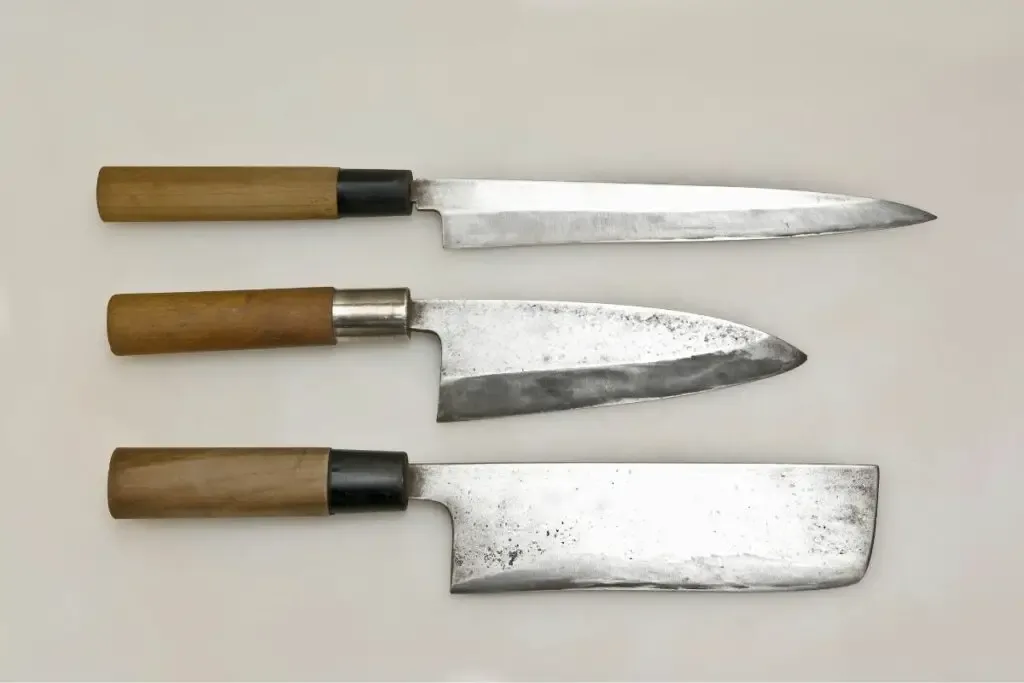
Most Japanese knives are designed and created with a particular purpose in mind. The characteristics of the blade are crafted to make the knife adept for the kitchen task the knife was intended for.
The task-focused design of Japanese knives means that most Japanese kitchen knives are not general-purpose, even if the knife can be used for more than one task.
Using a Japanese knife for a kitchen task for which it was not intended can seriously damage the blade or cutting edge. This damage to the edge can be expensive to repair and, in some instances, can ruin the knife completely.
If you are interested in buying some of the best whetstones for sharpening your Japanese knives, you can find them in the table below (all these whetstones are original Japanese sharpening stones):
| Usage | Grit Type | Best Option |
|---|---|---|
| Fixing stone | 320 grit | Shapton Kuromaku 320 |
| Establishing the Edge | 400 grit | Naniwa Chosera 400 |
| Sharpening Stone | 600 grit | Naniwa Chosera 600 |
| Sharpening Stone | 800 grit | Naniwa Chosera 800 |
| Finishing Stone | 1000 grit | Suehiro CERAX |
| Polishing Stone | 2000 grit | Shapton Kuromaku 2000 |
| Polishing Stone | 5000 grit | Shapton Kuromaku 5000 |
| Extra Polishing Stone | 8000 grit | Shapton Kuromaku 8000 |
| Mirror Polishing Stone | 12000 grit | Shapton Kuromaku 12000 |
Double Bevel Japanese Knives
Double bevel blades were not common in Japanese knives since the majority of their blades were traditionally single bevel.
The exposure of Western knives in the form of French and German blades to the Japanese people in the late 1800s saw many Japanese knife manufacturers adopt the double-bevel design.
This bevel style increased the mass behind the edge, making the edge more durable, with the accompanying sacrifice of some sharpness of the edge.
Consequently, many Japanese knives became available in both single and double-bevel versions, except where the change to a double bevel would limit the knife for its intended purpose. In most cases, this was in knives designed for particular or specialized culinary arts.
The growing popularity of Japanese knives in the Western world has further increased the adoption of double-bevel designs on the blades of many Japanese knife makers. This change was to cater to the growing Western market where people were more familiar with the use and care of double bevel blades.
TIP: Bevels are another aspect of knives that not many people consider until they start looking at the purpose a knife was designed for. Find out more in the article below:
Single Vs. Double Bevel Knife: What’s The Difference?
Single Bevel Japanese Knives
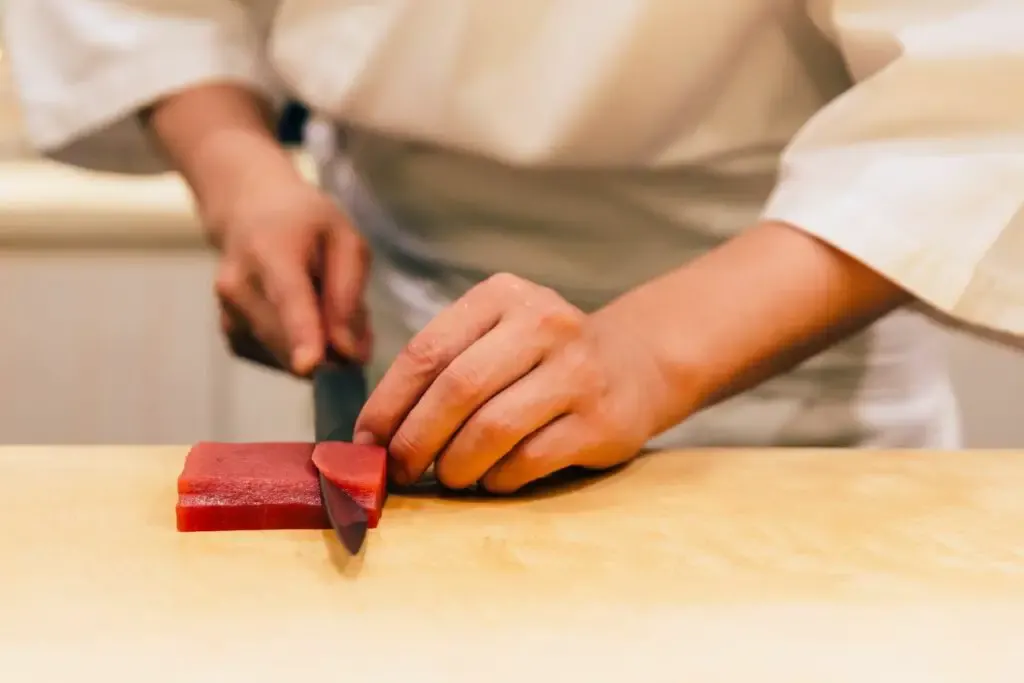
Traditionally, all Japanese knives were originally made as single-bevel knives. Single-bevel knives have a more delicate edge than double-bevel knives, which means that a single-bevel further reduces the tasks for which a knife can be used.
However, the single bevel has some advantages, especially in cuisine requiring clean, precise cuts. Single bevels can be sharpened to a higher level of sharpness than a double bevel blade, but single bevels are notoriously more difficult to sharpen correctly.
TIP: Single-bevel Japanese knives have benefits as well as some challenges, particularly in terms of the knife’s maintenance. Find out more about single-bevel Japanese knives in the article below:
Single Bevel Japanese Knife Types: Explanation & Usage
Traditional Japanese Knife Types
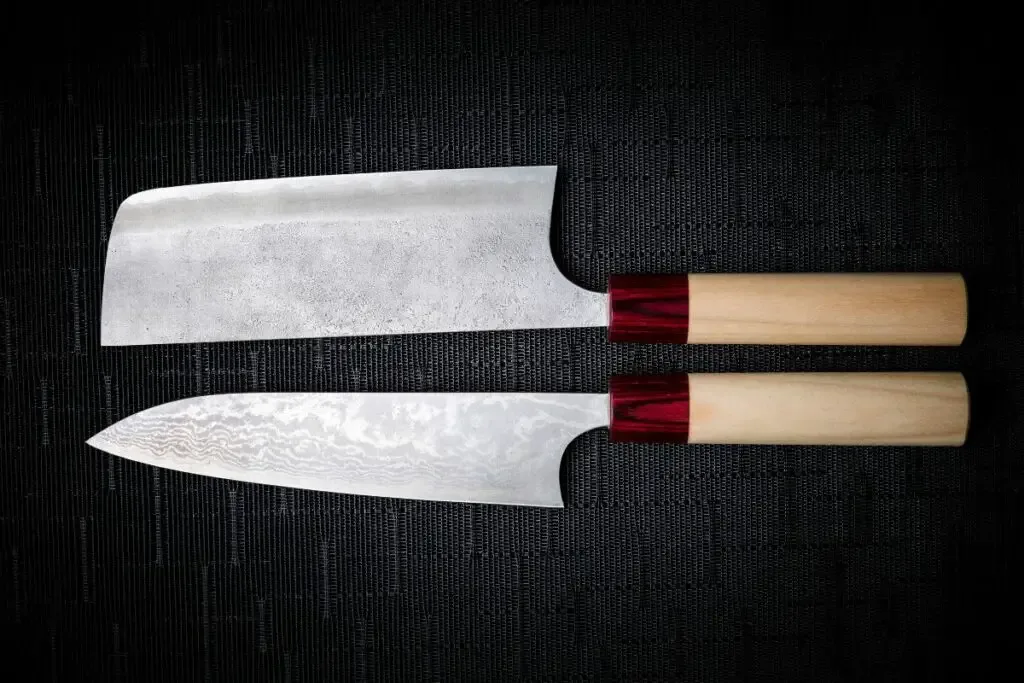
Many Japanese kitchen knives are uniquely suited to Japanese cuisine. These knives are considered traditional Japanese knife types and generally do not have much suitability for the Western kitchen.
While all Japanese kitchen knives have their roots in Japanese tradition and culture, many have been adapted to accommodate changing market demands. An example of this break from tradition is the inclusion of double bevel blades in many Japanese knives that were traditionally single bevels.
Typically, the specialty knives designed for specific aspects of Japanese cuisine have retained their traditional characteristics. This has resulted in these knives being labeled as “traditional” knives over the others that have adapted features to cater to changing trends.
TIP: Japan has a long history in the production of steel and manufacturing of superior quality blades. Check out the complete list of Japanese knife steel types in the article below:
Japanese Knives Steel Types (Complete List with Explanation)
All Japanese Knife Types
We have compiled a table of all Japanese knife types to act as a quick reference for the Japanese knife type and its intended role in the kitchen.
This helps you to see at a glance the type of knife you need in your kitchen for the type of food preparation you most frequently perform.
Bunka
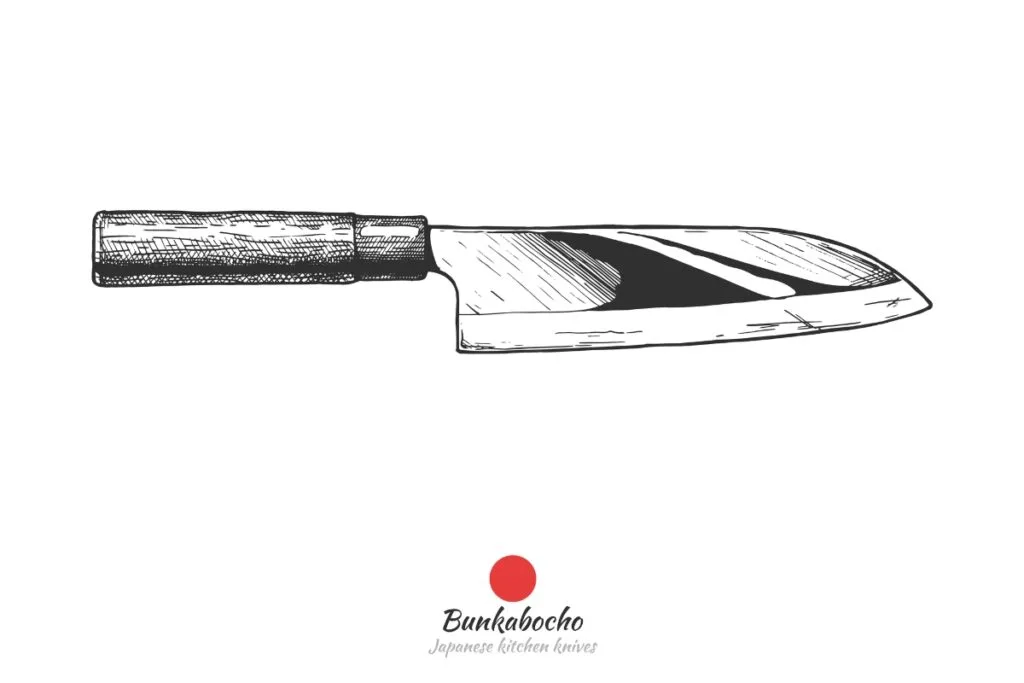
Purpose: A multi-purpose knife
Usage: Chopping vegetables, slicing fish and meat. Largely replaced by the Santoku.
Bevel: Double
Description: 165mm to 180mm or 6.5 inches and 7 inches – Wide blade with reverse tanto tip. Similar use as a Santoku, but less popular.
Chukabocho (Chinese Cleaver)
Purpose: Chopping
Usage: Chopping poultry, fish, herbs, and vegetables.
Bevel: Double
Description: 180mm to 240mm or 7 inches and 9.4 inches Tall cleaver-style blade.
Deba
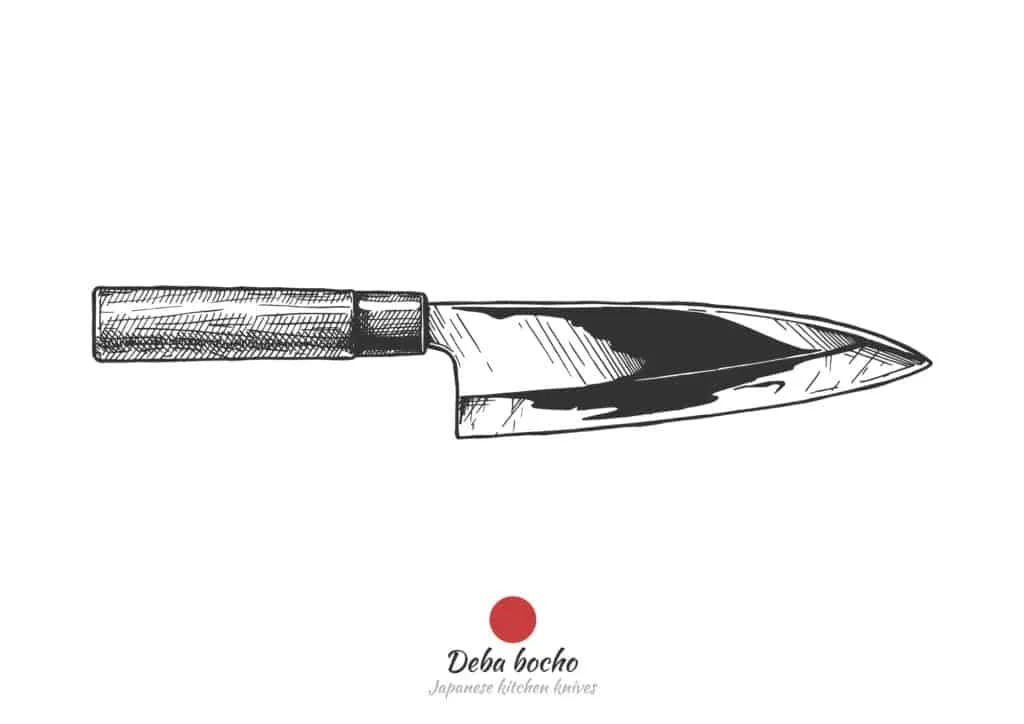
Purpose: Processing fish
Usage: Filleting fish, chopping fish, cutting through fish bones, including the head.
Bevel: Single
Description: 120mm to 210mm or 4.7 inches and 8.2 inches. Thicker steel to add more bulk behind the edge.
TIP: The Funayuki and the Deba are two Japanese kitchen knives that look very similar at first glance. Find out the differences between these knives in the article below:
Funayuki Vs. Deba: The 5 Differences That Matter
Fuguhiki
Purpose: Slicing blowfish (fugu)
Usage: A highly specialized knife for cutting ultra-thin, translucent slices of blowfish. Used in the making of blowfish sashimi using the Usuzukuri technique.
Bevel: Single
Description: 240mm to 300mm or 9.4 inches to 11.8 inches. Long, narrow blade, extremely sharp. It is used to cut thin slices of blowfish so the design of the plate can be seen through the slice of fish.
Funayuki
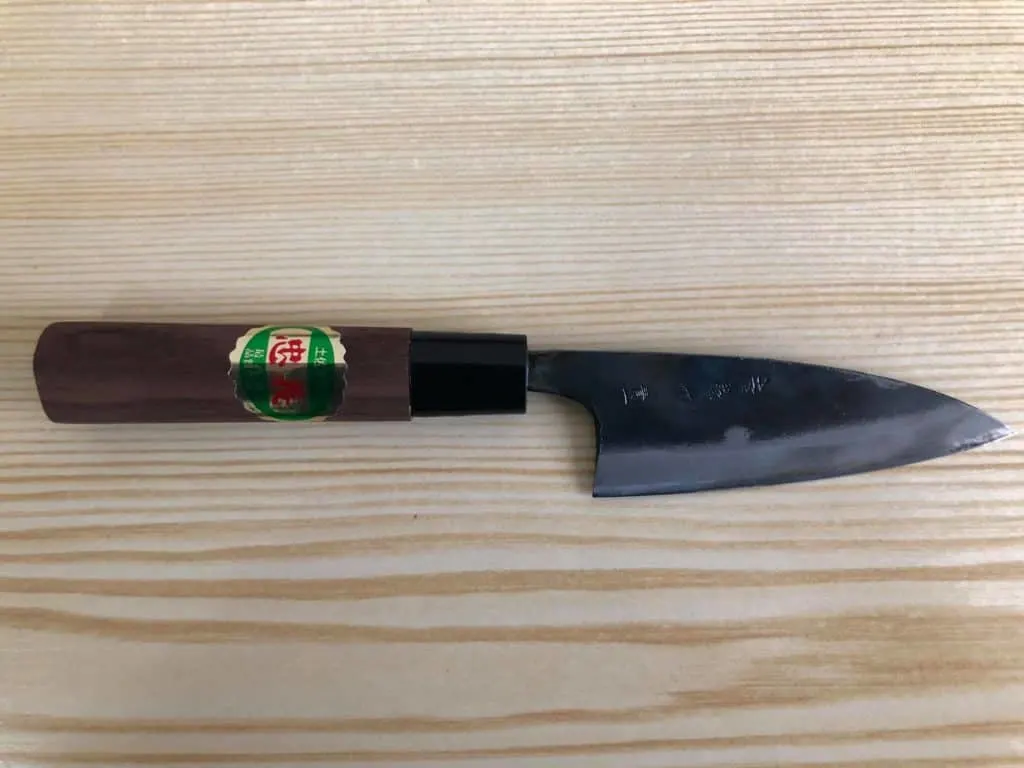
Purpose: Preparing fish and vegetables. It can also be used to break down poultry.
Usage: The traditional Japanese fisherman’s knife is used to process smaller fish and prepare meals on the boat.
Bevel: Traditionally single bevel but available in double bevel as well.
Description: 130mm to 180mm or 5.1 inches to 7 inches. The blade shape is triangular, similar to Deba, but lighter and thinner and more agile.
TIP: Funayuki and Yanagiba are both Japanese kitchen knives that can be used to process fish in the kitchen. Check out the differences in the article below:
Funayuki Vs. Yanagiba: The Main Differences You Should Know
Garasuki
Purpose: Boning knife for meat and poultry.
Usage: Used to debone larger poultry and larger cuts of meat. The blade should not be used to cut through bone but rather slice the meat away from the bone.
Bevel: Single bevel, but some double bevel variations are available.
Description: 170mm to 190mm or 6.7-inches to 7.5-inches. The distinct triangular shape of the blade is distinctive, high at the heel and tapering steeply to the sharp point. Similar to the Honesku in shape but larger, thicker, and heavier.
Gyuto
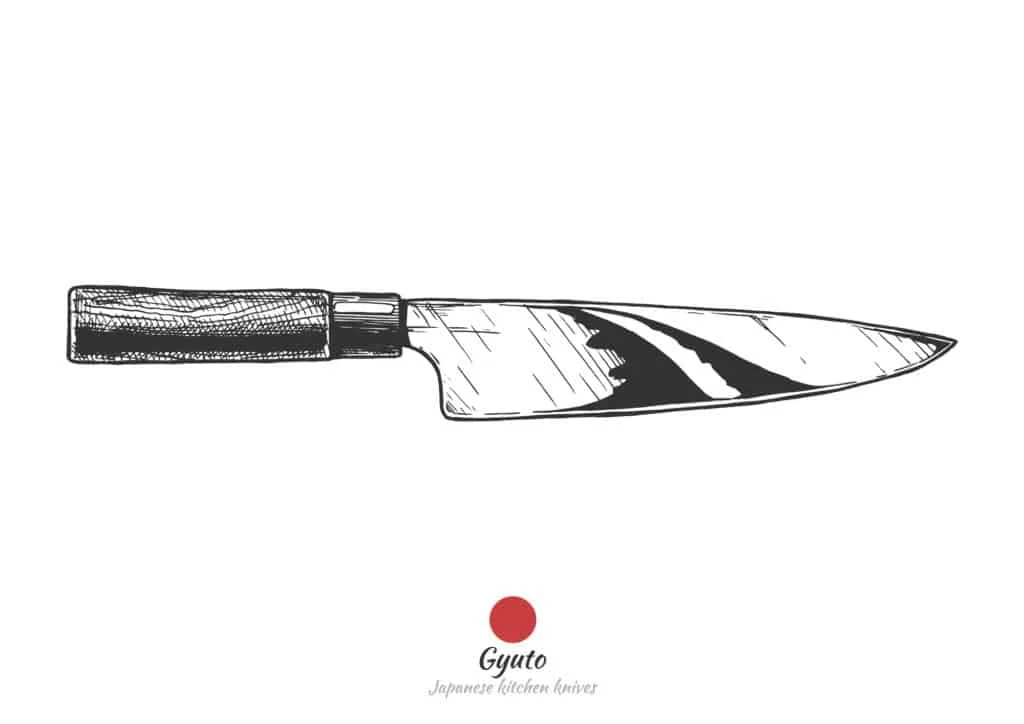
Purpose: Multi-purpose knife used for common tasks in the kitchen.
Usage: Suitable for slicing vegetables and fruit and chopping vegetables with a rocking action or fast chopping with the front of the blade. It is also useful for slicing raw meat of all kinds and carving cooked meat.
Bevel: Double versions are the most popular and versatile, but single bevel options are available.
Description: 210mm to 270mm or 8.2 inches to 10.6 inches. Japan’s version of a Western-style chef’s knife.
TIP: The Gyuto-style knife and the Funayuki knife are two such knives that have different designs and purposes. Find out more in the article below:
Funayuki Vs. Gyuto: The 5 Essential Differences
Hamokiri / Honekiri
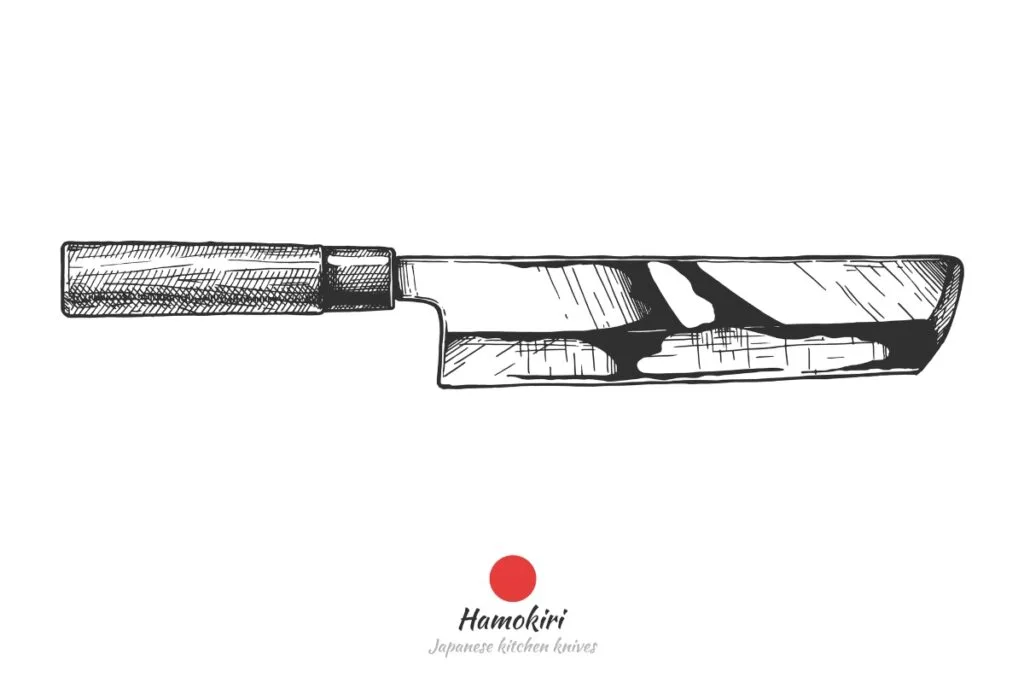
Purpose: Purpose made for slicing pike conga, a form of marine eel.
Usage: This knife is made for one purpose: cleaning and preparing pike conga.
Bevel: Single bevel.
Description: 240mm to 300mm or 9.4 inches to 11.8 inches. Narrow, straight, non-tapering blade ending in a tanto tip.
Hankotsu
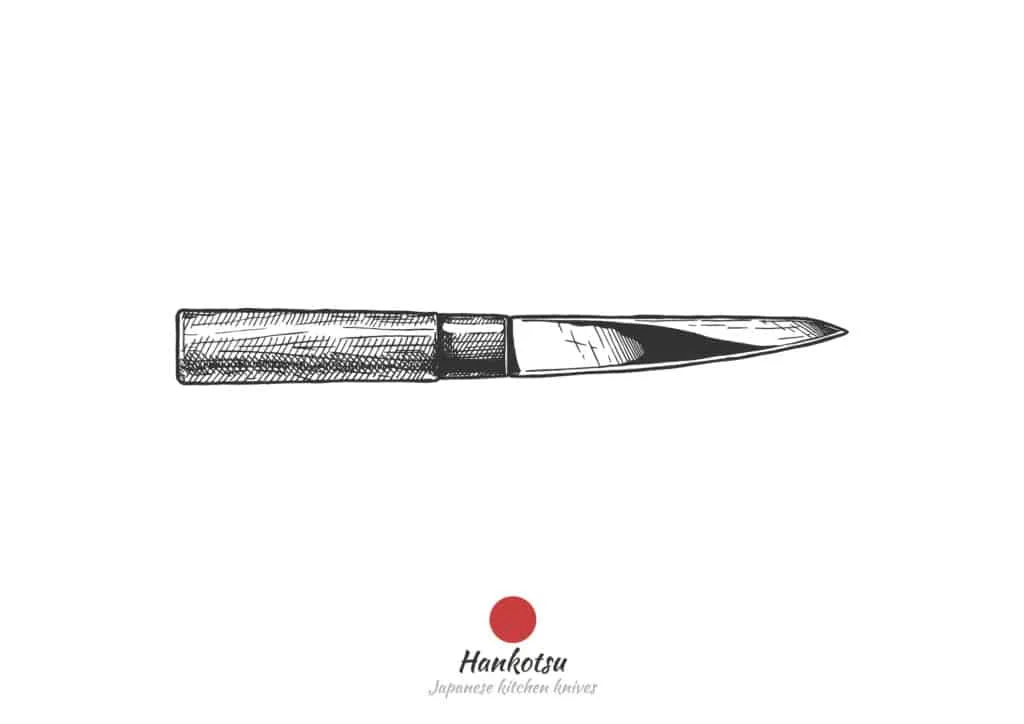
Purpose: Butchering hanging beef carcasses.
Usage: Used to break down hanging beef or other carcasses. It is often used in a reverse grip to pull the knife down through the meat. Separates meat from the bone and is sturdy enough to cut through cartilage and tough meat but not bone. It is also used to cut fish and chicken.
Bevel: Double bevel.
Description: 150mm or 6-inches. A relatively short, stout, sturdy blade capable of rough work. This is a useful knife if you work with large cuts of meat or break down carcasses into component cuts. Popular in Western kitchens for Frenching racks of ribs or cutting chops.
Honesuki
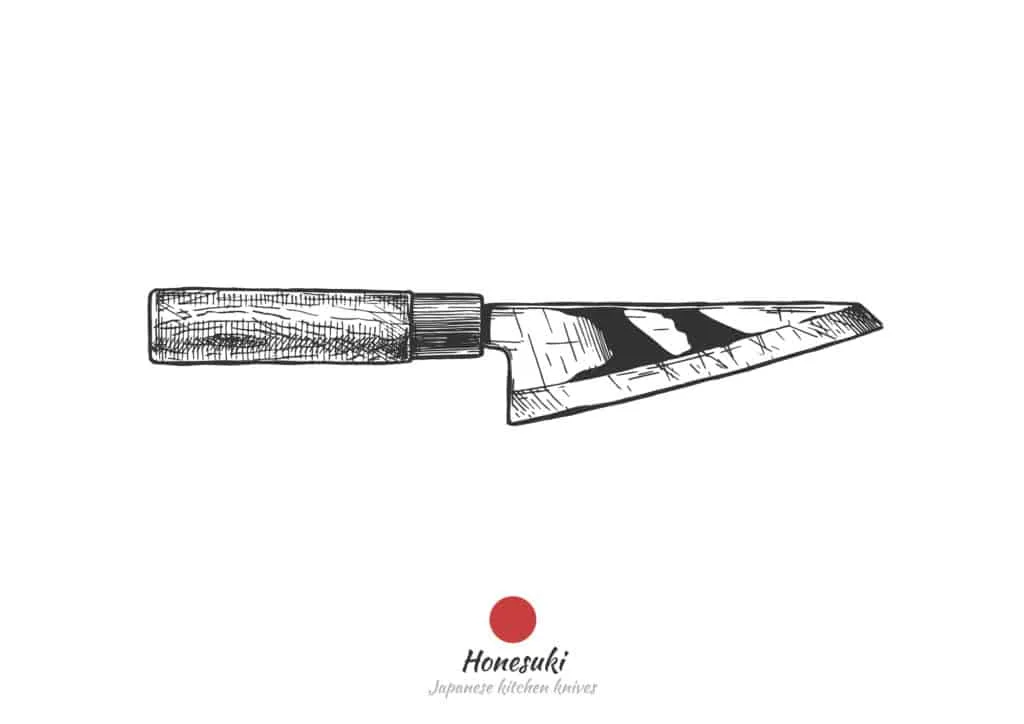
Purpose: Boning poultry, processing poultry cuts.
Usage: Separating poultry carcasses into component parts. It can be used to cut through joints to separate the carcass but not bone. The Garasuki, a more robust knife, can be used to cut through poultry bones.
Bevel: Single or Double Bevel.
Description: 135mm to 180mm or 5.3 inches to 7 inches. The medium-sized triangular blade is stiff and robust, with the tip designed to penetrate poultry joints and cut ligaments and cartilage.
TIP: Honesuki and hankotsu knives are both knife styles for processing meat. Check out the differences between these two knives in the article below:
Honesuki vs. Hankotsu: What’s The Difference?
Katsuobushi-kiri
Purpose: Used for slicing bonito or skipjack tuna.
Usage: A specialty knife used to cut thin scales of bonito or skipjack tuna used in a variety of dishes. Katsuobushi means bonito.
Bevel: Single bevel.
Description: 65mm or 2.5-inches. The short-blade knife is used exclusively for preparing thin slices of bonito for a variety of Japanese dishes. The knife resembles a wood carving knife.
Kiritsuke
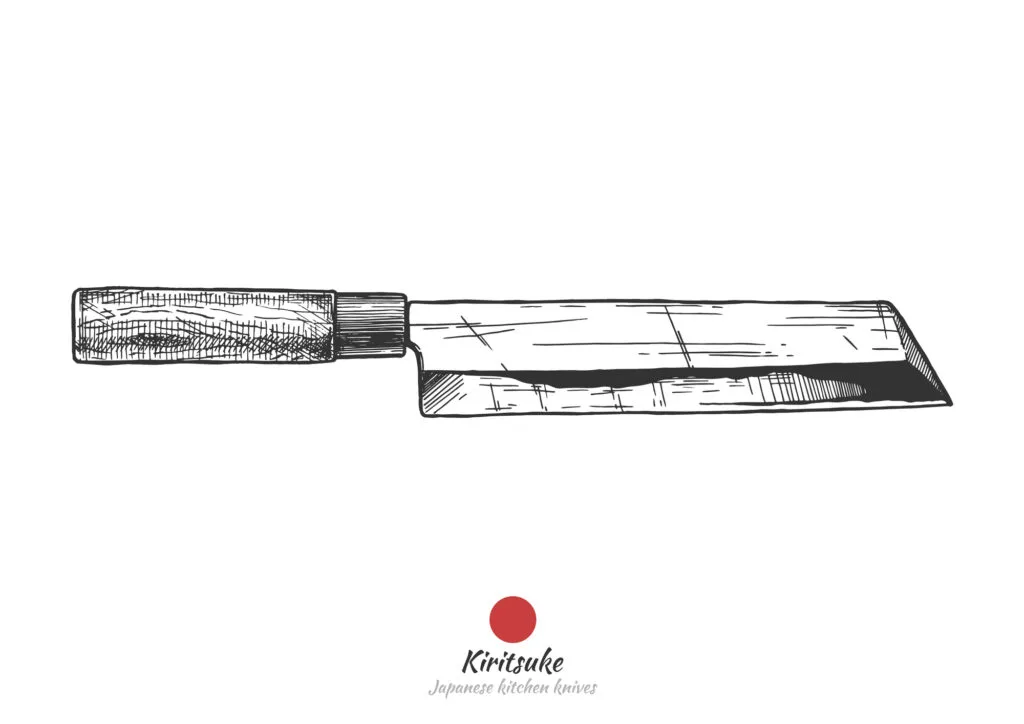
Purpose: Slicing fish and chopping vegetables.
Usage: Combining the features of the Yanagiba and Usuba, the Kiritsuke can be used to slice fish and chop vegetables with the blade’s heel. Special knife skills are needed to use this blade, making it normally reserved for use by the head chef.
Bevel: Primarily single bevel but can be double bevel.
Description: 240 mm-300 mm or 9.4 inches to 11.8 inches. Features a narrow blade with a reverse tanto tip.
Magurokiri
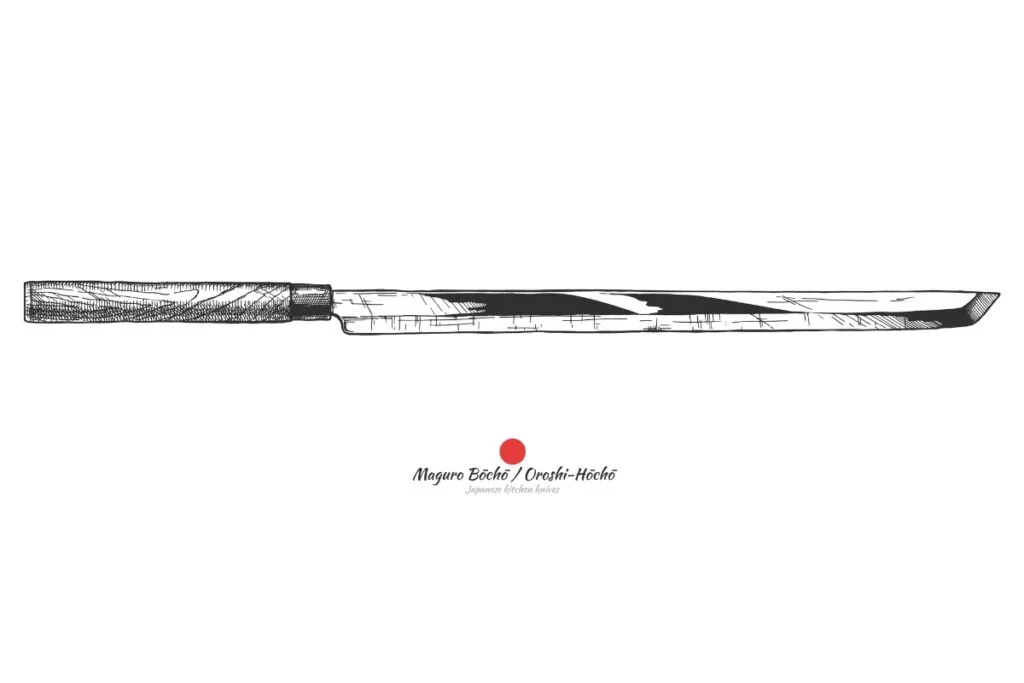
Purpose: Specialty knife for filleting and cutting giant tuna.
Usage: This knife is used primarily for processing large tuna. A long blade is required to slice all the way through these large fish.
Bevel: Single bevel.
Description: 600mm to 900mm or 26.3 inches to 35.4 inches. The blade resembles a small samurai sword. The long blade is slender with a tanto tip.
Mukimono
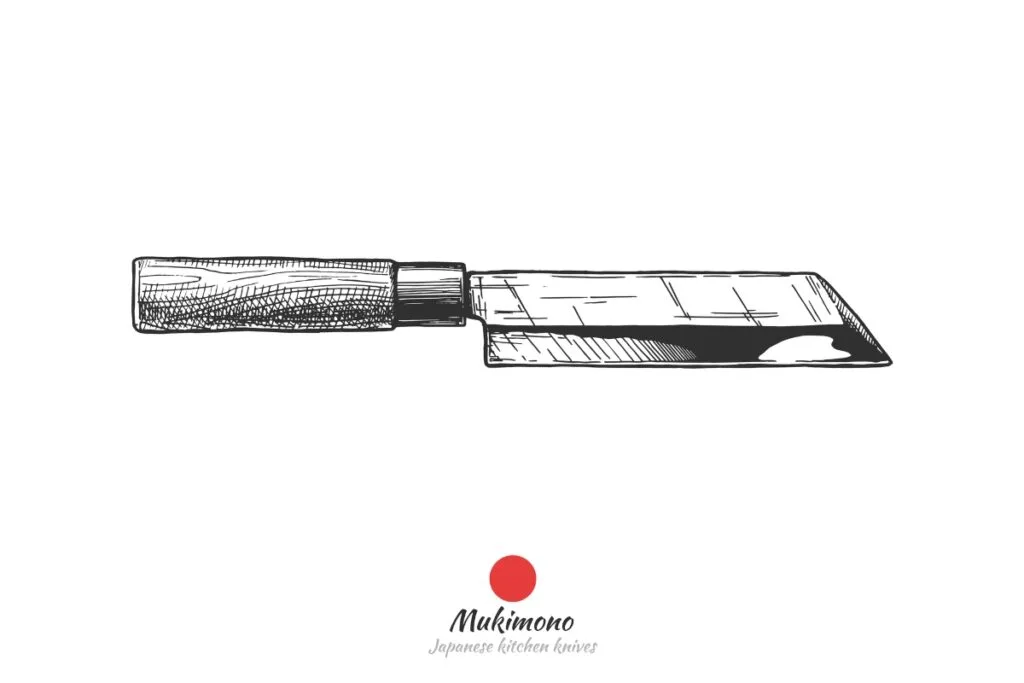
Purpose: Decorative vegetable and garnish cutting.
Usage: A generally small knife, used for the art of Mukimono or decorative garnish cutting and the art of Kazari-Giri or decorative vegetable carving, also used as a general-purpose fruit and vegetable peeling and slicing knife.
Bevel: Single bevel.
Description: 75mm to 210mm or 2.95 inches to 8.2 inches. The thin, slender, short blade ends in a reverse tanto tip.
Nakiri
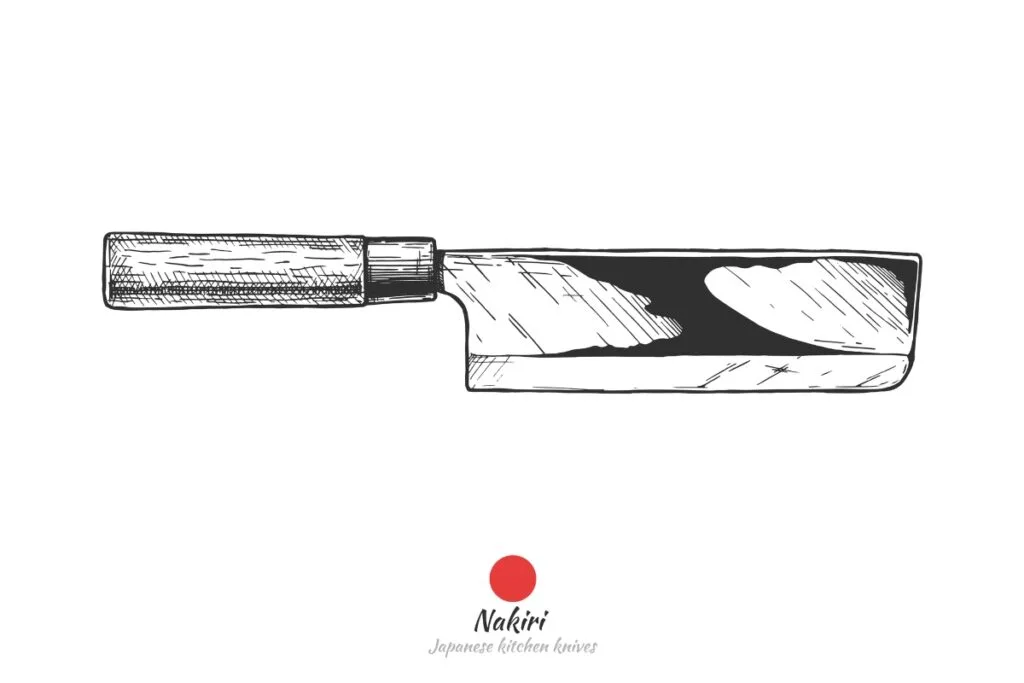
Purpose: Vegetable processing.
Usage: Chopping and slicing vegetables, fruit, and herbs. This is a popular knife choice for vegetarians and is one of the popular Japanese knives sought after by Western cooks.
Bevel: Double bevel.
Description: 165mm to 180mm or 6.5 inches to 7 inches. The short, square-shaped blade resembles a cleaver and is popular in both Western and Eastern kitchens for processing vegetables, fruit, and herbs.
TIP: The Nakiri, or more accurately, the Nakiri bocho, is one such purpose-built knife in the Japanese kitchen knife style. Find out more in the article below:
10 Reasons You Need A Nakiri Knife (Honest Review)
Pankiri
Purpose: Cutting bread and pastries.
Usage: This knife is designed similarly to Western bread knives, with the familiar serrated edge to effectively cut bread and pastry with tough outer crusts and soft interiors.
Bevel: Single bevel, serrated edge.
Description: 210mm to 270mm or 8.2 inches to 10.6 inches. A long slender blade, sometimes with a slight triangular profile and a sharp point, but more commonly rectangular with a square or slightly rounded tip.
Petty
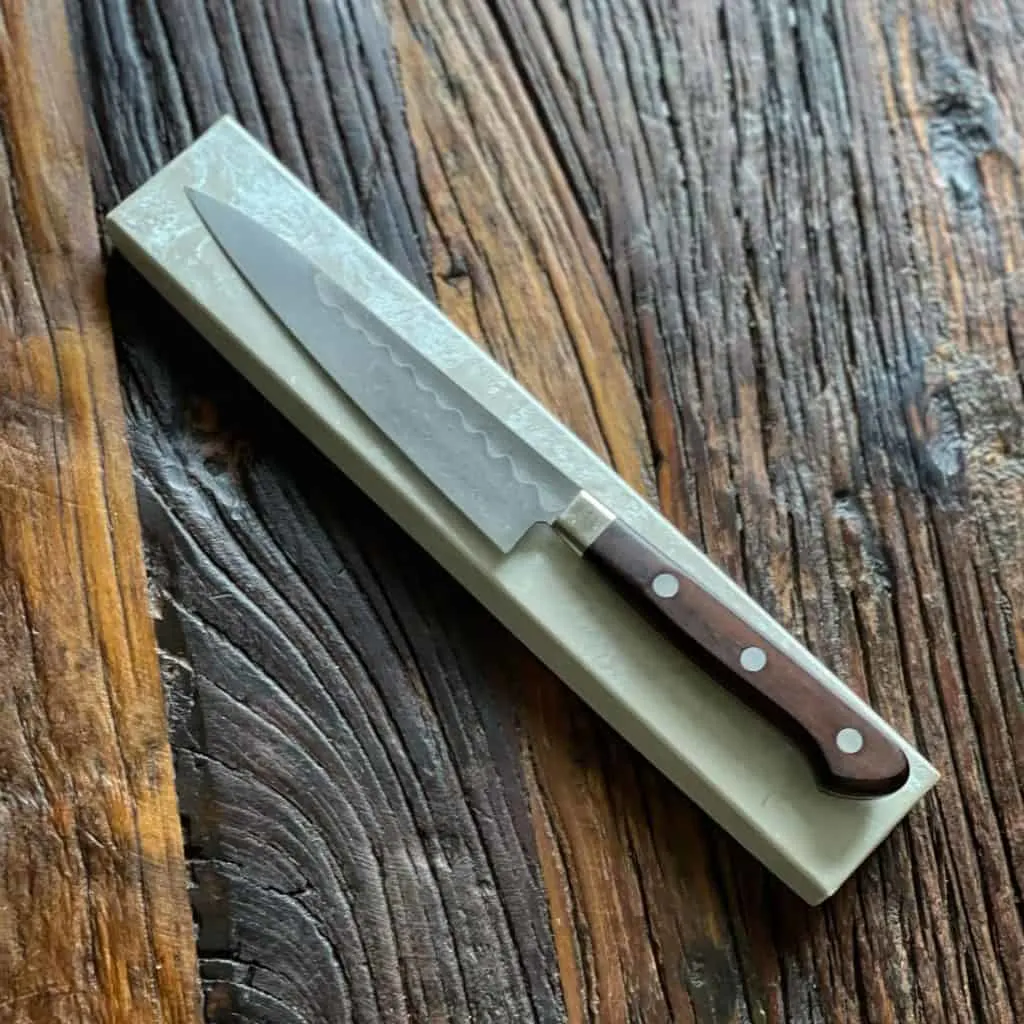
Purpose: A multifunctional utility knife. Used for peeling, chopping, and slicing fruit, vegetables, and herbs. It can also be used to slice small pieces of meat.
Usage: Along with the Gyuto, the Petty is one of the most useful and versatile knives in the kitchen. The Petty is often compared to the Gyuto and used as a companion to this knife for processing smaller ingredients.
Bevel: Double bevel.
Description: 120mm to 180mm or 4.7 inches to 7 inches. A compact, slender, nimble blade, easily controllable for performing precise cuts.
Santoku
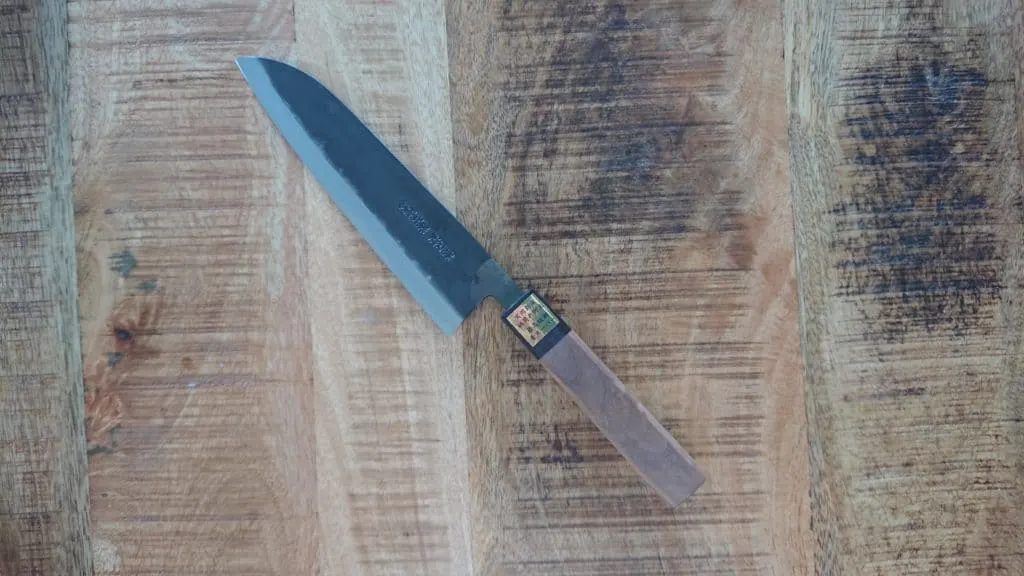
Purpose: Multi-purpose smaller version of the Gyuto. Used to process fish and vegetables but can slice smaller cuts of meat.
Usage: The Santoku is considered a smaller version of a Gyuto and can be used to perform similar functions in the kitchen but on a smaller scale. This is another popular knife in Western and Japanese kitchens, particularly home kitchens.
Bevel: Double bevel.
Description: 165mm to 180mm or 6.5 inches to 7 inches. The sharp edge is less curved than a Gyuto and has a rounded sheep’s foot tip rather than a sharp point.
TIP: Santoku and funayuki are two such Japanese design knives of similar size. Find out the differences between these two knives in the article below:
Santoku vs. Funayuki: Six Main Differences You Should Know
Sobakiri
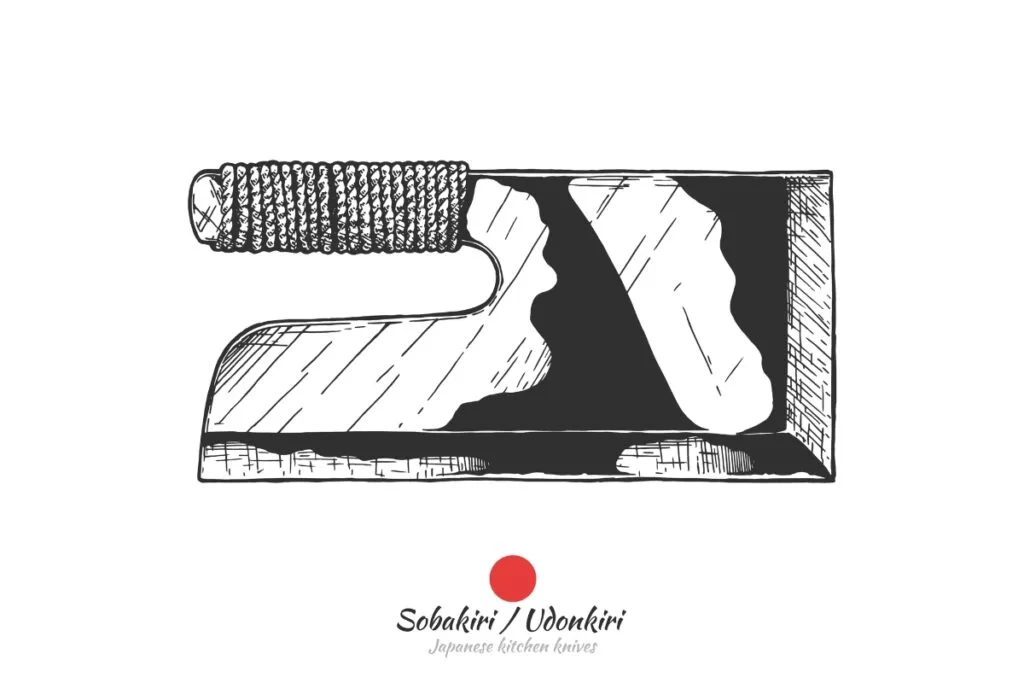
Purpose: Exclusively for cutting Japanese noodles or Soba.
Usage: This is a specialty knife that essentially has one purpose in the kitchen – cutting noodles.
Bevel: Single bevel.
Description: 210mm to 300mm or 8.2 inches to 11.8 inches. A tall blade that resembles a cleaver, with the cutting edge extending below the length of the handle.
Sujihiki
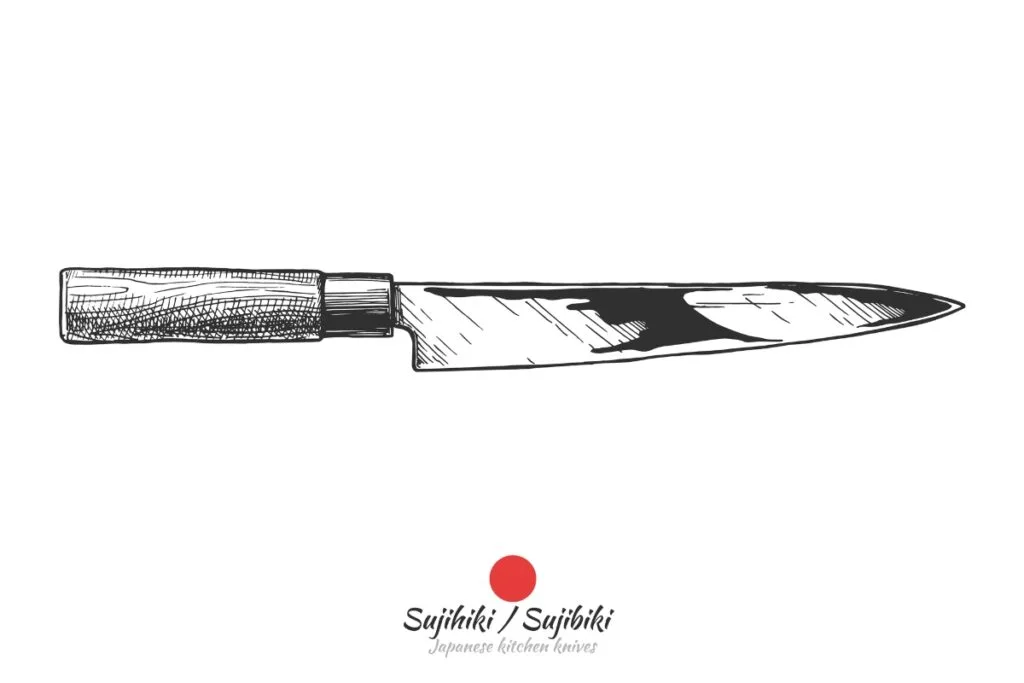
Purpose: Slicing meat, trimming sinew and fat from meat. Also used to slice boneless fish.
Usage: This long blade is useful for slicing large cuts of boneless meat and fish. The cut is made in a single draw cut, made possible by the length of the blade.
Bevel: Double bevel.
Description: 240mm to 300mm or 9.4 inches to 11.8 inches. This is a long, slender knife used to slice meat in a single long draw cut.
Takohiki / Takobiki
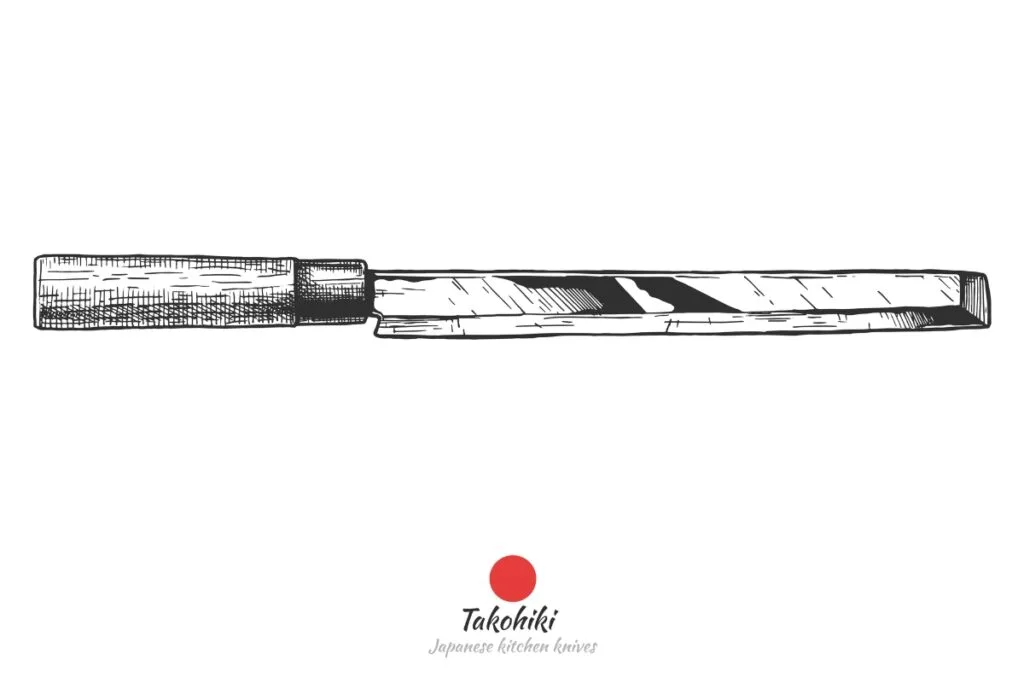
Purpose: Slicing fish, particularly octopus.
Usage: Tako means octopus in Japanese, and slicing octopus tentacles is the main design purpose of this knife. The Takohiki can also be used to slice other boneless fish.
Bevel: Single bevel.
Description: 210mm to 330mm or 82 inches to 13 inches. Long, slender knife with no curve on the cutting edge. The tip is square and is often used to transfer sliced pieces from the cutting board to the serving plate.
Unagisaki
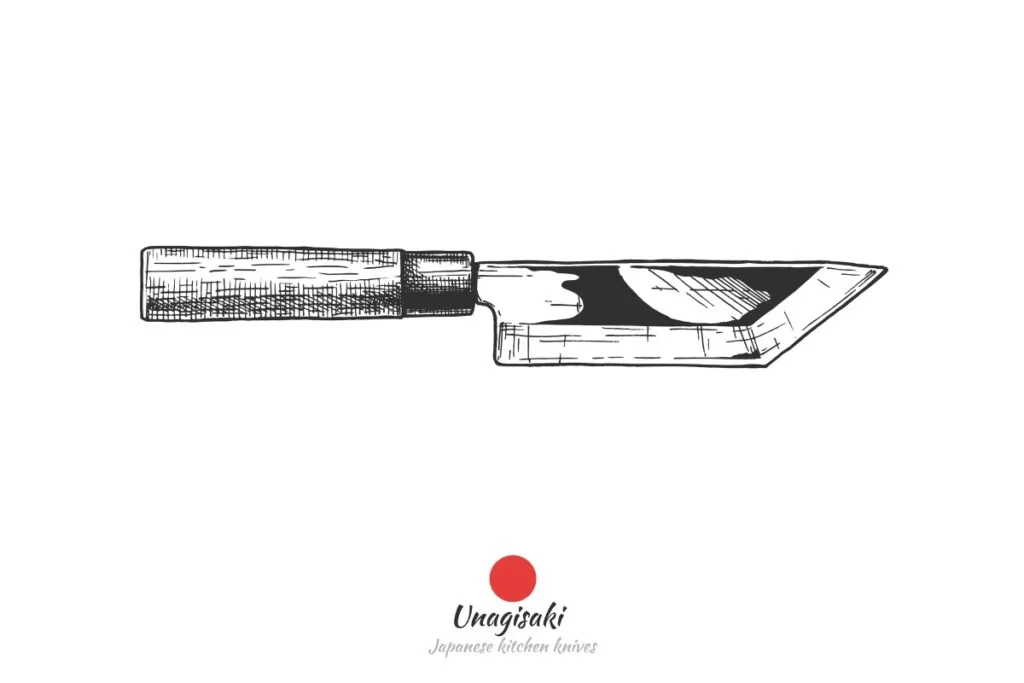
Purpose: Filleting and slicing eel.
Usage: This is a single-purpose knife used for filleting and slicing eel. It could be used to slice other boneless fish.
Bevel: Single bevel.
Description: 130mm to 180mm or 5.1 inches to 7 inches. The medium-sized blade has a steeply angled tanto tip with a very sharp point used to pierce the body of the eel.
Usuba
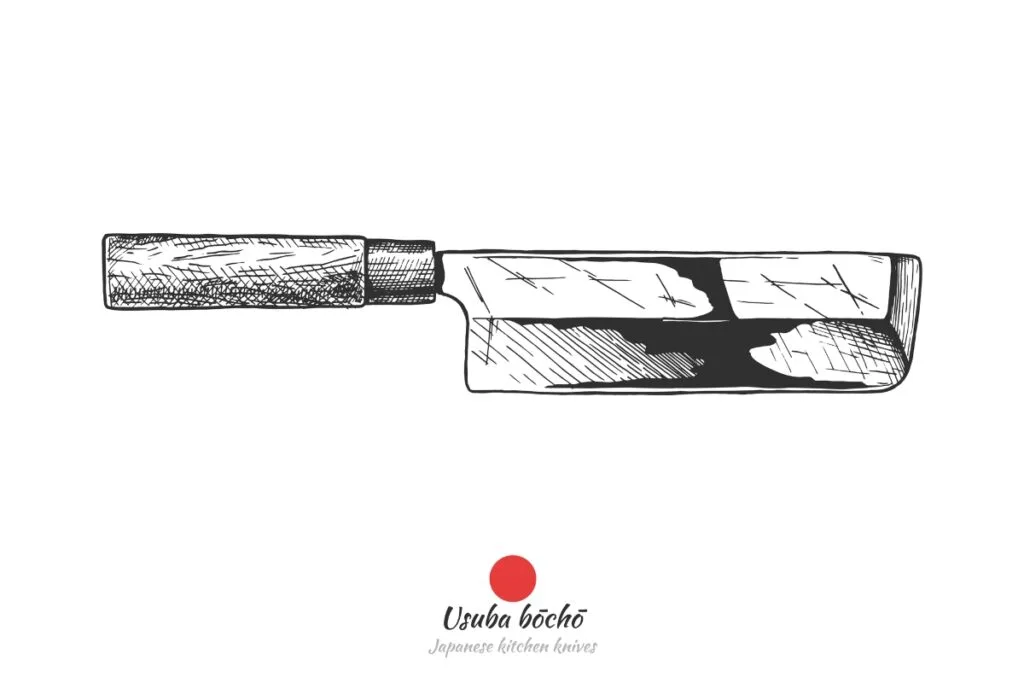
Purpose: Vegetable processing.
Usage: The extremely thin, sharp edge can be used to slice fruit and vegetables in a rotary action, creating thin, flat sheets of the ingredient. This sheet can then be sliced or chopped to any size, depending on the dish. The Usuba is generally used to slice or chop vegetables that are to be eaten raw. The sharp edge reduces cell damage and bruising of the ingredient.
Bevel: Single bevel.
Description: 180mm to 300mm or 7 inches to 11.8 inches. A narrow rectangular blade with a square tip. Some variations have a rounded tip.
Yanagiba
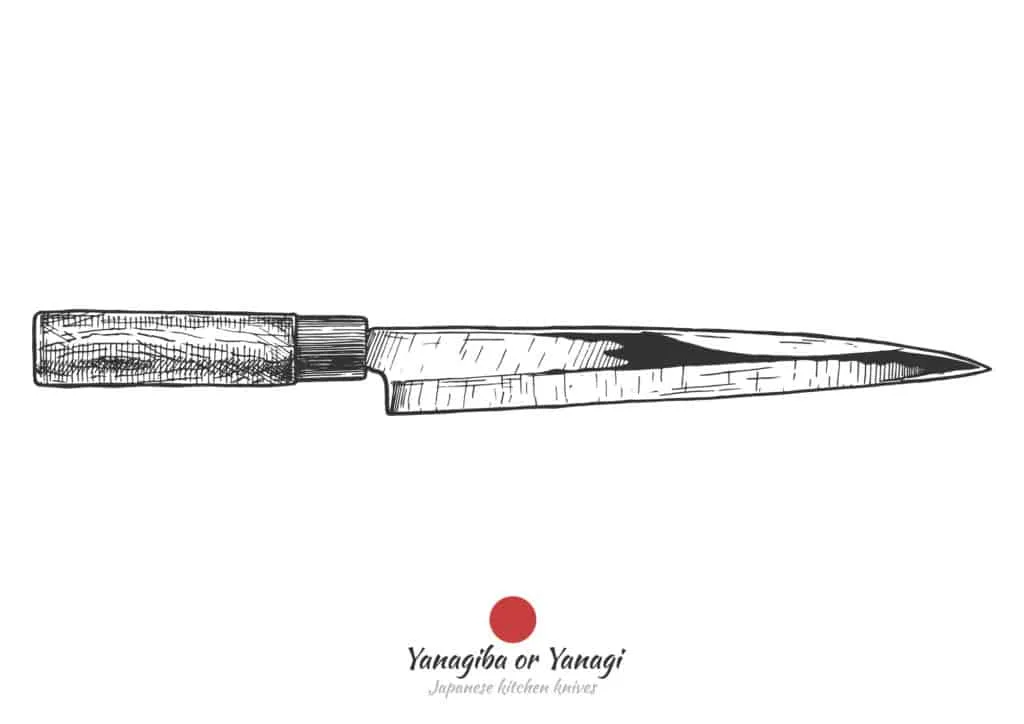
Purpose: Skinning and filleting fish. Slicing thin slices of boneless fillets for sashimi and sushi.
Usage: The very sharp edge does not bruise the fish, which helps to preserve the taste of fish that will be eaten raw. This is the most sought-after Japanese knife for fish processing and slicing fish for sashimi and sushi. The length of the blade allows the fish to be cut with a single draw stroke of the blade, which preserves the texture of the fish.
Bevel: Single-bevel but double-bevel variants are available.
Description: 210mm to 330mm or 8.2 inches to 13 inches. The long, slender, willow leaf-shaped blade tapers delicately to a sharp, pointed tip.
TIP: Choosing your first Japanese knife can raise a few questions. Check out the ultimate guide on choosing your first Japanese knife in the article below:
Choosing Your First Japanese Knife (Ultimate Guide + Tips)
What Is The Most Versatile Japanese Knife?
The most versatile of Japanese knives is undoubtedly the Gyuto, which is the Japanese equivalent of a chef’s knife.
The Gyuto will be the most commonly used knife in general, and its ability to process meat, vegetables, fruit, and herbs makes it one of the most versatile Japanese knives.
The Gyuto is often paired with either a Santoku or a Petty, which are also extremely versatile knives. The Santoku and the Petty are often used on smaller tasks for which the Gyuto is simply too large, but they can process similar ingredients to the Gyuto.
BTW: If you want to know more about Japanese and other knives and their sharpening, check out the books listed above. These books are recommended by professional sharpeners and knife makers (Amazon links):
- Japanese Kitchen Knives: Essential Techniques and Recipes
- The Knifenerd Guide to Japanese Knives
- Knife: The Culture, Craft, and Cult of the Cook’s Knife
- Sharp: The Definitive Introduction to Knives, Sharpening, and Cutting Techniques, with Recipes from Great Chefs
Which Japanese Knife is Best for You?
Choosing the right Japanese knife for your kitchen is not just about adding a beautiful tool to your collection; it’s about enhancing your cooking experience and efficiency.
The perfect knife depends largely on what you do in the kitchen and the types of food you typically prepare. Here’s how to make the best choice:
Understand Your Cooking Style and Needs
- Type of Cuisine: If you often prepare Japanese dishes, especially sushi or sashimi, specialized knives like the Yanagiba or Deba are ideal. For more general cooking, versatile knives like the Santoku or Gyuto are better suited.
- Common Tasks: Do you find yourself slicing, dicing, or chopping more? For slicing fish and meats, longer, slender knives like the Sujihiki are perfect. For chopping vegetables, the Nakiri offers a straight edge ideal for up-and-down motions.
- Skill Level: Some Japanese knives require skill and practice to use effectively, especially single-bevel knives. If you’re a beginner, start with a double-bevel knife like a Gyuto or Santoku, which are more forgiving and versatile.
Consider the Knife’s Characteristics
- Blade Shape and Size: The shape and size of the blade determine its suitability for different tasks. A longer blade is better for slicing, while a shorter, broader blade is ideal for chopping.
- Single vs. Double Bevel: Single-bevel knives offer precision and are great for specific tasks like making sushi. Double-bevel knives are more versatile and easier to maintain, making them suitable for a variety of kitchen tasks.
- Weight and Balance: A well-balanced knife feels comfortable in your hand and reduces fatigue. The weight of the knife should match your preference for a heavy or light feel during use.
Why This Choice Matters
- Efficiency and Precision: The right knife can significantly improve your efficiency in the kitchen. A well-suited knife glides through ingredients, reducing prep time and enhancing precision.
- Maintaining the Integrity of Ingredients: Japanese knives are renowned for their sharpness. A sharp, appropriate knife causes less damage to the cellular structure of ingredients, preserving flavor and texture, especially important in dishes where ingredients are consumed raw.
- Safety: Using the right knife for the right task reduces the risk of accidents. A knife designed for the task at hand is easier to control, making your kitchen a safer place.
- Longevity of Your Knives: Using a knife for its intended purpose not only ensures optimal performance but also prolongs its life. Misusing a knife can lead to damage, requiring costly repairs or replacements.
The best Japanese knife for you is one that aligns with your cooking habits, skills, and the types of dishes you frequently prepare.
This thoughtful selection ensures a harmonious blend of functionality, safety, and culinary artistry in your kitchen. Remember, a knife is not just a tool; it’s an extension of your hand in the culinary world.
Conclusion
Understanding the purpose of each type of Japanese knife will assist your decision-making when purchasing knives for use in your kitchen.
Using a Japanese kitchen knife outside of its intended purpose can damage the knife and ruin your investment.
Consequently, you will need multiple knives for different tasks in the kitchen. For most knife fans, this is not a hardship since these knives are functional and have a beauty of their own.
Once you have experienced the unrivaled superior performance of a Japanese kitchen knife, you will soon be planning to add more to your collection!
TIP: Patience, attention to detail, and some basic knowledge will get you sharpening your Japanese knife like a pro in no time! Check out the complete guide in the article below:
Sharpen Japanese Knife Like A PRO (Single & Double Bevel)

